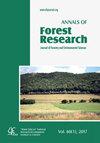利用NAIP图像和机载激光雷达在美国阿拉巴马州和密西西比州沿海地区检测入侵植物
IF 2.9
3区 农林科学
Q2 FORESTRY
引用次数: 0
摘要
入侵植物对世界各地的原生生态系统造成了严重威胁。牛脂树(Triadica sebifera)和女贞树(Ligustrum sinense)是美国南部最多产的入侵物种,需要紧急评估以保护沿海生态系统。缺乏对这些入侵物的空间明确评估,加上高分辨率遥感数据的日益可用性,为后续监测提供了绘制分布图的机会。本研究的总体目标是在生态敏感的沿海地区建立牛脂树和中国女贞的空间综合地图。该研究在阿拉巴马州和密西西比州的三个沿海地区进行:(1)莫比尔天索河三角洲,(2)邦塞库国家野生动物保护区,(3)密西西比沙丘鹤国家野生动物保护区。我们实现了三种图像分类方法,分别代表无监督、有监督和机器学习技术:(1)ISODATA,(2)最大似然(ML)和(3)随机森林(RF)。对于每种分类,首先检查1 m的国家农业成像计划(NAIP)正射影像,然后将植被结构和地形参数整合到机载光探测和测距(LiDAR)中。利用NAIP叠加图像与LiDAR衍生变量相结合的RF模型,获得了87.5%的最高总体精度(OA)。总的来说,研究结果强调了利用现成的遥感数据准确表征牛油树和中国女贞的潜力。本研究的地图产品代表了重要入侵物种的空间综合基线清单,并将为更广泛的测绘和监测工作的框架发展提供信息。本文章由计算机程序翻译,如有差异,请以英文原文为准。
Detection of invasive plants using NAIP imagery and airborne LiDAR in coastal Alabama and Mississippi, USA
Invasive plants have imposed severe threats to native ecosystems worldwide. Triadica sebifera (Tallow tree) and Ligustrum sinense (Chinese privet) are among the most prolific invasive species in the southern United States (US) that needs urgent assessment to protect coastal ecosystems. The lack of spatially explicit assessments of these invasives, coupled with the increasing availability of high-resolution remotely sensed data, represents an opportunity to produce a distribution map for subsequent monitoring. The overall goal of this study was to develop spatially comprehensive maps of Tallow tree and Chinese privet in ecologically sensitive coastal regions, where both invasives have become well established. The study was conducted in three coastal sites within Alabama and Mississippi: (1) Mobile Tensaw River Delta, (2) Bon Secour National Wildlife Refuge, and (3) Mississippi Sandhill Crane National Wildlife Refuge. We implemented three image classification methods, representing unsupervised, supervised, and machine learning techniques, respectively: (1) ISODATA, (2) Maximum Likelihood (ML), and (3) Random Forest (RF). For each classification, a 1 m National Agriculture Imagery Program (NAIP) orthoimage was first examined, then integrated with vegetation structure and topography parameter derived from airborne light detection and ranging (LiDAR). The maximum Overall Accuracy (OA) of 87.5% was obtained using RF model with NAIP stacked image integrated with LiDAR derived variables. Overall, findings highlight the potential for accurately characterizing both Tallow tree and Chinese privet using readily available remote sensing data. Mapped products from this study represent a spatially comprehensive baseline inventory of crucial invasive species and will serve to inform the development of a framework for broader-scale mapping and monitoring efforts.
求助全文
通过发布文献求助,成功后即可免费获取论文全文。
去求助
来源期刊

Annals of Forest Research
FORESTRY-
CiteScore
2.20
自引率
11.10%
发文量
11
审稿时长
12 weeks
期刊介绍:
Annals of Forest Research is a semestrial open access journal, which publishes research articles, research notes and critical review papers, exclusively in English, on topics dealing with forestry and environmental sciences. The journal promotes high scientific level articles, by following international editorial conventions and by applying a peer-review selection process.
 求助内容:
求助内容: 应助结果提醒方式:
应助结果提醒方式:


